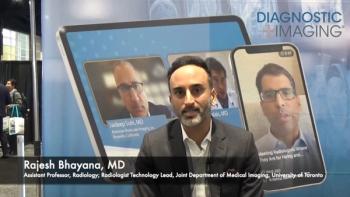
New Siemens U.S. chief rationalizes production
Victory in the battle for U.S. medical imaging sales will go tothose vendors that can produce advanced equipment at reduced cost.The days of technical glitz at almost any price--fading sincethe onset of DRGs--are over. Imaging suppliers now vie for
Victory in the battle for U.S. medical imaging sales will go tothose vendors that can produce advanced equipment at reduced cost.The days of technical glitz at almost any price--fading sincethe onset of DRGs--are over. Imaging suppliers now vie for competitiveadvantage with new weapons, such as improved productivity andcost-efficient manufacturing.
Encouraged by incoming president and CEO Robert V. Dumke, SiemensMedical Systems has initiated a zero-based review of operationsto boost productivity and rationalize manufacturing across bothmedical and nonmedical operations. SMS of Iselin, NJ, is the U.S.subsidiary of Siemens' worldwide medical business based in Erlangen,Germany.
Dumke, formerly head of Siemens Industrial Automation (SIA),replaced retiring Robert J. MacKinnon as medical CEO this fall(SCAN 9/22/93).
"Every business has its own set of challenges. But behindevery challenge is an opportunity. You have to look for the opportunityand maximize it," Dumke said.
The challenge of health-care reform is clear: Scanner pricesmust be kept down without sacrificing quality. The opportunityfor Siemens lies in leveraging strengths that run across its broadmedical product portfolio and utilizing company expertise foundoutside of the medical business, he said.
Following the integration earlier this year of all Siemens'U.S.-based medical companies into business groups and operatingsubsidiaries reporting directly to SMS (SCAN 4/7/93), the vendorinitiated a program to rationalize component manufacturing acrossfactories. Medical imaging factories in the U.S. include nuclearmedicine, ultrasound and PACS.
"We have taken all printed circuit board manufacturingout of medical, transferring it to (Siemens) Industrial Automation,"Dumke told SCAN. "Every one of our (U.S.) factories had printedcircuit board fabrication. None of them were operating on a fullshift; their volume was too low. They didn't have the most up-to-dateequipment. SIA will fabricate boards using three shifts a day,seven days a week. This will drive down the cost of manufacturing."
Sheet metal supply and painting will move in the other direction.SIA, Siemens Ultrasound and other factories had previously contractedoutside the company for cabinetry and other metal products. Thisfunction will now be centered in a single, yet-to-be-determinedmedical factory with existing production capability.
"(Centralizing fabrication) will provide benefits in termsof quality control, reduction of inventory and better cost coverageon most of our advanced equipment," he said.
MOST OF SIEMENS' MEDICAL FACTORIES will upgrade manufacturingwhile continuing their operations. However, SMS did have to suspendproduction--and product shipments--at its Siemens Medical Laboratorieslinear accelerator facility in Concord, CA. The move was voluntaryand not related to Food and Drug Administration oversight of thefacility, he said.
"We had to build additional test cells to increase throughputand remove very heavy pieces of equipment. Some of the processeswill also be changed, so we have to retrain people to the newprocedures," Dumke said. "We are also going to be changingsoftware, which then needs to be revalidated. All of these activitiescould not be done at the same time that the products were goingout the door. We are making a tremendous effort to do this ina short period of time."
Restructuring of procedures has been made easier by the consolidationof medical companies under the SMS umbrella, he said. Previously,U.S. companies like Siemens Ultrasound and Siemens Gammasonicsfunctioned with considerable autonomy.
"Now, we can ensure a common strategy and common policiesand look for synergies between the groups. We didn't do that before,"Dumke said. "With a company as large as we are--approaching$2 billion (in annual sales)--you can't have little pieces eachgoing in its independent direction."
Company productivity is increasing under economic pressure.SMS reduced staff during the past year by over 600 positions,or about 10% of the current level of 6500, he said.
But the company is growing in areas that add efficiencies.For instance, SMS is starting up a remote servicing and technicalassistance center for MRI and other imaging users. The on-linecenter, which will be located near the company's North Carolinatraining facility, should improve customer service and boost fieldservice productivity, Dumke said.
BRIEFLY NOTED:
- Acuson has created a new division to oversee its Aegisimage distribution product line (SCAN 10/21/92). All componentsof Aegis featured by Acuson as a work-in-progress at the 1992RSNA meeting are now operational, according to John Freund, executivevice president.
Logistical challenges that emerged when the first Aegis unitswere installed encouraged Acuson to form a division around it,said Freund, who supervises the division.
"Acuson needs to retrain the entire hospital or clinicdepartment on how their work flow will improve as Aegis's featuresare introduced," he said.
Newsletter
Stay at the forefront of radiology with the Diagnostic Imaging newsletter, delivering the latest news, clinical insights, and imaging advancements for today’s radiologists.




























